How to create a PowerPoint file password
On Office tools, there is an option to create a password to protect the content, to avoid being copied by others. With PowerPoint, it is possible to set a password to secure the contents of the slide. Setting a password for a PowerPoint slide can choose to completely lock the file, need to enter the correct password to open the slide or just allow it to be opened and read but not allowed to edit the content. To create passwords for PowerPoint slides, we will use the built-in features immediately without the need for software or support tools. The following article will guide you how to create a PowerPoint slide password.
- How to prevent others from copying and editing Word files
- Password setting tools for PDF files
- How to set Excel password to secure data file
- How to create a password protection for Excel sheets
1. How to set a password to open a PowerPoint file
Step 1:
In the PowerPoint file the user wants to create a password click on the File item and then click on the Protect Presentation section in the next interface. Display the options menu, click Encrypt with Password .

Step 2:
Display password entry interface. We type the password to lock the PowerPoint slide so that other people don't open it. Enter an additional password to confirm the created password.

Step 3:
When you set the successful password in the PowerPoint interface, you will see a message to enter the password to open the file.
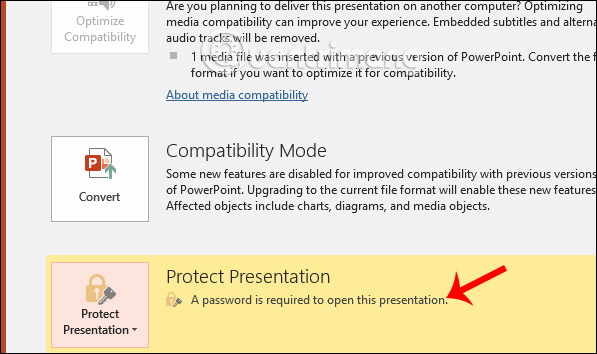
When another person opens the PowerPoint file or you open the file again, you will get the interface that requires you to enter the correct password to open the file.
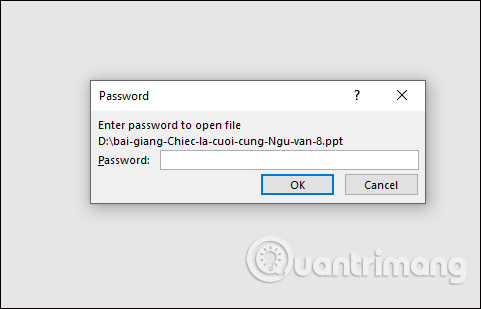
Step 4:
To remove the password set for PowerPoint slides , we click on File, then choose Protect Presentation and then click Encrypt with Password to delete the password .
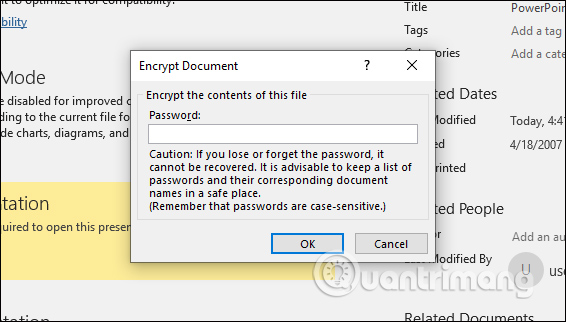
2. Create PowerPoint password to prevent editing
Step 1:
We also click on File and then select the Save As option .
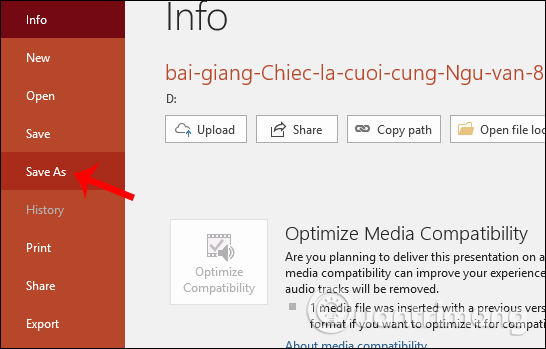
Step 3:
Next you proceed to save this PowerPoint file as a new file. In the Tools section, click on General Options .

Step 4:
Display interface to enter passwords for PowerPoint slides. In the Password to open section, enter the password to open the file. To enter a password that allows reading content but is not edited, we use the Password to Modify option . Enter the password, click OK to save.
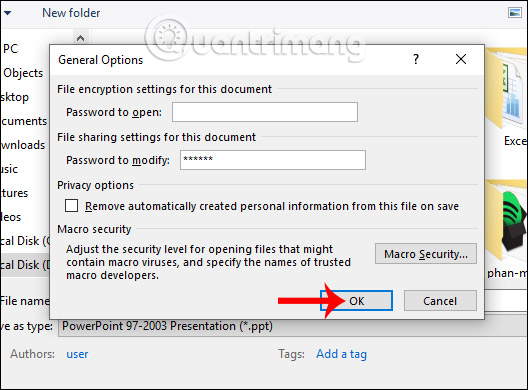
When other people open the file, they also get the interface asking for the correct password. Then just click the Read Only button to read the content without entering a password.
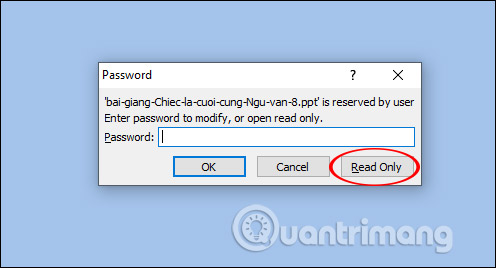
To remove the password , you must enter the correct password and click OK to open the file.

Click on Save As , select the new file file and then click Tools , select General Options to display the password entry interface for Ready-Only mode. Delete the set password at Password to Modify and then click OK.
Exit the interface to save the new file and then click Save to save the new settings for the slide.
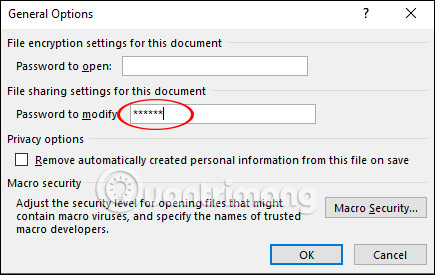
So users have two different ways to create passwords for PowerPoint slides, passwords to open files and only allow reading without editing the content. To unlock it, just repeat the steps to create the password and then delete the password that is set.
I wish you all success!
You should read it
- How to make PowerPoint for beginners
- 50 alternative slideshow applications for PowerPoint
- Instructions to resize Slide pages in PowerPoint
- Manage slides in PowerPoint 2016
- Beautiful free PowerPoint slides for office workers
- How to adjust the slide thumbnail in PowerPoint
- How to Loop in PowerPoint on PC or Mac
- Beautiful free PowerPoint slides for teachers
May be interested
- How to Convert Powerpoint to Mp4
 powerpoint is great for creating slideshows, but they can be difficult to share if the recipient doesn't have powerpoint installed. one easy way to share your presentations is to create an mp4 video file. this will allow you to play it on...
powerpoint is great for creating slideshows, but they can be difficult to share if the recipient doesn't have powerpoint installed. one easy way to share your presentations is to create an mp4 video file. this will allow you to play it on... - Create slides from a template available in PowerPoint
 the following article introduces you in detail how to create a presentation from a template available in powerpoint. step 1: open powerpoint - go to file - new - select the template available in groups
the following article introduces you in detail how to create a presentation from a template available in powerpoint. step 1: open powerpoint - go to file - new - select the template available in groups - Create slides from an existing slide in PowerPoint
 the following article introduces you in detail. create slides from an existing slide in powerpoint. step 1: open powerpoint - go to file - open - select the powerpoint file to apply:
the following article introduces you in detail. create slides from an existing slide in powerpoint. step 1: open powerpoint - go to file - open - select the powerpoint file to apply: - How to Convert PowerPoint to Word
 this wikihow teaches you how to convert a microsoft powerpoint presentation to a microsoft word document format using the 'create handouts' feature on powerpoint for windows computers or export to an rtf file (rich text format) in powerpoint for mac computers. the current version of powerpoint on mac does not have the 'create handouts' feature. rtf files may not accurately convey all formatting of some powerpoint features, so images and backgrounds may not be supported.
this wikihow teaches you how to convert a microsoft powerpoint presentation to a microsoft word document format using the 'create handouts' feature on powerpoint for windows computers or export to an rtf file (rich text format) in powerpoint for mac computers. the current version of powerpoint on mac does not have the 'create handouts' feature. rtf files may not accurately convey all formatting of some powerpoint features, so images and backgrounds may not be supported. - How to lock, not edit PowerPoint files
 this article will guide you to lock powerpoint files with a password to protect your presentation content.
this article will guide you to lock powerpoint files with a password to protect your presentation content. - How to remove PDF file password - Use PDF Password Cracker Pro software
 setting a password for pdf files is the simplest way to protect the content inside. however, sometimes you want to cancel the password you created to make it more convenient to share with everyone.
setting a password for pdf files is the simplest way to protect the content inside. however, sometimes you want to cancel the password you created to make it more convenient to share with everyone. - How to set Excel password to secure data file
 setting up excel password has many ways, from simple to use excel's built-in password feature to use vba. below tipsmake.com will show you the most basic ways to protect your excel file.
setting up excel password has many ways, from simple to use excel's built-in password feature to use vba. below tipsmake.com will show you the most basic ways to protect your excel file. - Set password to protect and encrypt documents in Office 2013
 the password and document encryption feature in office 2013 is applicable for both word, excel and powerpoint and is very effective in protecting sensitive data despite extremely simple implementation. however, many people may be unfamiliar with these two great features. the article will show you how to create a password
the password and document encryption feature in office 2013 is applicable for both word, excel and powerpoint and is very effective in protecting sensitive data despite extremely simple implementation. however, many people may be unfamiliar with these two great features. the article will show you how to create a password - How to Duplicate Slides in PowerPoint
 this wikihow teaches you how to create copies of slides in powerpoint. open your powerpoint presentation if it isn't already open. to do so, either double-click the presentation file, or open powerpoint and select the file's name from the...
this wikihow teaches you how to create copies of slides in powerpoint. open your powerpoint presentation if it isn't already open. to do so, either double-click the presentation file, or open powerpoint and select the file's name from the... - How to create a Roadmap in PowerPoint
 roadmap maps in powerpoint often appear in project content, goals or tasks that need to be done according to a clear and specific route.
roadmap maps in powerpoint often appear in project content, goals or tasks that need to be done according to a clear and specific route.










 How to open Microsoft Word from Command Prompt
How to open Microsoft Word from Command Prompt How to fix the Circular Reference error in Excel
How to fix the Circular Reference error in Excel Useful Adobe Acrobat shortcuts
Useful Adobe Acrobat shortcuts How to delete photos in bulk in Excel
How to delete photos in bulk in Excel How to change the default font in PowerPoint
How to change the default font in PowerPoint How to add graphics to Word documents 2019
How to add graphics to Word documents 2019